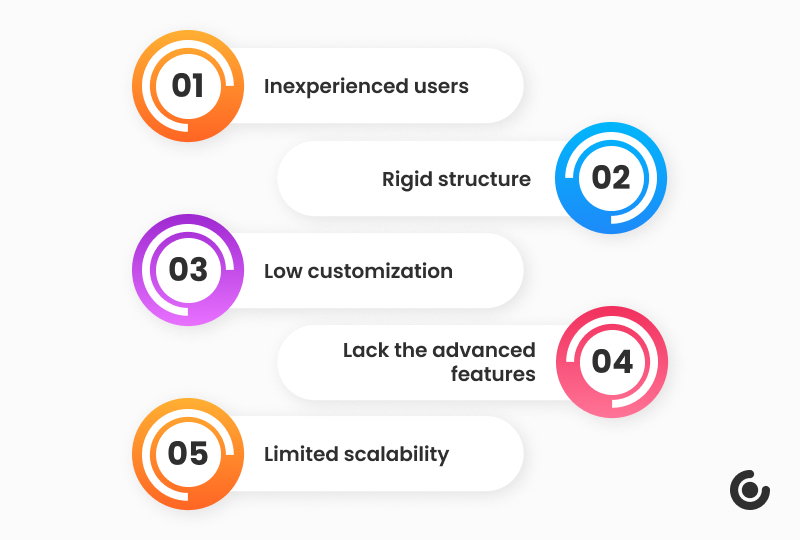Exploring the Rapid Rise of Low-Code/No-Code Platforms

Table of Contents
Low-code/no-code (LCNC) platforms are mobile and web application development tools that allow users to configure and deploy applications with minimal coding or no coding at all. LCNC tools have witnessed a meteoric rise in the past few years, fueled by the rising demand for digital solutions and the easy accessibility that they offer. In this article, we explore the features, benefits, challenges and uses associated with low-code/no-code platforms, and examine who is using them and what the future holds.
What are Low-Code/No-Code Platforms?
Low-code/no-code platforms (LCNC) are solutions that enable users to develop mobile (iOS, Android) and web applications quickly and simply. With LCNC solutions, users are not required to know programming languages. Rather, they can use drag-and-drop functionality for quick app development and deployment. Typical components found in LCNC platforms include: design tools for creating layouts and user interfaces; integration tools that enable quick and easy connection with databases and APIs; deployment tools for distributing applications; analytics tools for tracking and optimizing performance; and security tools for ensuring safe usage. These platforms further aid in rapid prototyping of applications, cloud hosting capabilities, collaboration tools, pre-built components and more.
Low-code/no-code platforms are becoming increasingly popular due to their ease of use and cost-effectiveness. They are ideal for businesses of all sizes, from small startups to large enterprises, as they allow for rapid development and deployment of applications. Additionally, they are often more secure than traditional development methods, as they are built with security in mind. Low-code/no-code platforms are also highly scalable, allowing businesses to quickly and easily add new features and functionality as their needs evolve.
Benefits of Low-Code/No-Code Platforms
LCNC platforms offer tremendous benefits when compared with traditional coding. First, they are incredibly easy to use, with user-friendly drag-and-drop elements that simplify the development process. Second, they have quick learning curves, enabling anyone regardless of their programming knowledge to create complex solutions within a relatively short amount of time. Third, they enable agile development, where changes can be made quickly and smoothly through the platform’s user-friendly interface. Finally, they can help cut down time-to-market as LCNC platforms don’t require in-depth coding or manual debugging, thus helping organizations rapidly deploy applications and gather user feedback.
In addition, LCNC platforms are cost-effective, as they require fewer resources and personnel to develop applications. This makes them ideal for small businesses and startups that may not have the budget to hire a team of developers. Furthermore, LCNC platforms are highly scalable, allowing organizations to quickly and easily add new features and functionality as their needs evolve. Read more
Challenges of Low-Code/No-Code Platforms
Though providing numerous benefits, LCNC solutions also pose certain challenges. First, due to the low barrier for usage, these platforms attract many inexperienced users who may feel overwhelmed with navigating the platform’s options. Furthermore, LCNC platforms rigidly structure the application building process which can hinder developers looking for optimal flexibility and customization capabilities. Moreover, these solutions are not ideally suited for developing sophisticated, enterprise-level applications and lack the advanced features required by such users.
Additionally, LCNC platforms are often limited in terms of scalability and may not be able to handle large volumes of data or traffic. Furthermore, the lack of coding knowledge can lead to inefficient applications that are difficult to maintain and debug. Finally, LCNC platforms may not be able to integrate with existing systems, making it difficult to leverage existing data and resources.
Uses of Low-Code/No-Code Platforms
LCNC platforms are used in a wide range of industries and applications, including marketing, finance, healthcare, retailing and more. In marketing, these solutions enable businesses to generate leads with landing pages, carry out marketing campaigns with dynamic forms and measure ROI with powerful analytics tools. In financial services, users can build financial calculators and track managing cash flows quickly and efficiently. In healthcare, LCNC offers solutions such as lab analysis and ordering systems, patient engagement apps and more. In retailing, services such as point-of-sale applications and customer portals can be rapidly set up on these platforms.
The advantages of using LCNC platforms are numerous. They are cost-effective, easy to use, and require minimal technical knowledge. They also allow businesses to quickly develop and deploy applications, without the need for coding. This makes them ideal for businesses that need to quickly develop and deploy applications, without the need for coding. Additionally, LCNC platforms are highly scalable, allowing businesses to easily add new features and functionality as their needs evolve.
Who is Using Low-Code/No-Code Platforms?
LCNC platforms are being adopted by businesses of all sizes—from startups and SMEs to large enterprises. Startups and SMEs are attracted to LCNC solutions due to their affordability and ease of use while larger companies turn to them to efficiently create nimble applications across several departments quickly. Additionally, new app development teams without prior coding experience use LCNC platforms in order to rapidly create new apps, or to modernize or upgrade existing ones.
LCNC platforms are also being used by organizations to create custom applications that are tailored to their specific needs. This allows them to quickly develop applications that are tailored to their unique business processes and requirements. Furthermore, LCNC platforms are being used to create applications that are more secure and reliable, as they are built on a secure and reliable platform.
Popular Low-Code/No-Code Platforms
The bottom line is that organizations want mobile or web applications that can be quickly set up. To fulfill this requirement, numerous vendors have emerged in the LCNC space providing app development solutions. Popular examples include Microsoft PowerApps, OutSystems, Salesforce App Cloud, Oracle Visual Builder Cloud Service, Appian Platform and Mendix Platform.
These platforms provide a range of features and capabilities, such as drag-and-drop user interfaces, pre-built components, and integration with existing systems. They also offer a variety of pricing models, from free to enterprise-level plans. Additionally, many of these platforms offer support for multiple programming languages, allowing developers to customize their applications.
What the Future Holds for Low-Code/No-Code Platforms
Continued advances in technology will bring massive opportunities for low-code/no-code vendors seeking to take advantage of the boom in digital technologies. AI and machine learning will be increasingly utilized by these platforms to develop smarter enterprise solutions. Furthermore, edge computing is becoming increasingly popular and low-code/no-code platforms will have to find ways to exploit this technology without sacrificing the ease of use that they provide. Finally, predictive analytics is expected to play a bigger role in upcoming LCNC platforms as it provides real-time insights into user behavior that helps users refine their apps accordingly.
In addition, low-code/no-code platforms are expected to become more user-friendly and intuitive, allowing users to create complex applications with minimal effort. This will be achieved through the use of drag-and-drop interfaces, which will enable users to quickly and easily build applications without having to write any code. Furthermore, these platforms will also be able to integrate with existing systems, allowing users to quickly and easily create applications that are tailored to their specific needs. Read more
Frequently asked questions
What is a low code platform?
In addition to offering a GUI-rich development environment, a low-code platform or low-code development platform extensively incorporates visual programming principles to streamline, improve, and democratize conventional programming tasks. In reality, a low-code platform can speed up the software development cycle.
What is the difference between low-code and no-code platforms?
While no-code platforms generally enable business users without any coding knowledge to address their own development needs, low-code platforms are most frequently used by IT professionals with some coding skills to create custom applications.
Is low code secure enough?
Today's low-code platforms even at their most basic level provide security safeguards. They can integrate with current testing tools and conduct performance and vulnerability tests automatically. By automating security procedures, developer output is greatly increased.





